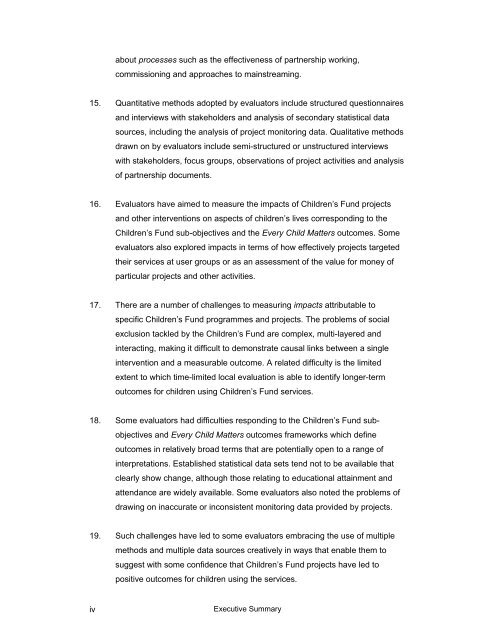Local Evaluation of Children's Services Learning from the Children's ...
Local Evaluation of Children's Services Learning from the Children's ...
Local Evaluation of Children's Services Learning from the Children's ...
- No tags were found...
Create successful ePaper yourself
Turn your PDF publications into a flip-book with our unique Google optimized e-Paper software.
about processes such as <strong>the</strong> effectiveness <strong>of</strong> partnership working,commissioning and approaches to mainstreaming.15. Quantitative methods adopted by evaluators include structured questionnairesand interviews with stakeholders and analysis <strong>of</strong> secondary statistical datasources, including <strong>the</strong> analysis <strong>of</strong> project monitoring data. Qualitative methodsdrawn on by evaluators include semi-structured or unstructured interviewswith stakeholders, focus groups, observations <strong>of</strong> project activities and analysis<strong>of</strong> partnership documents.16. Evaluators have aimed to measure <strong>the</strong> impacts <strong>of</strong> Children’s Fund projectsand o<strong>the</strong>r interventions on aspects <strong>of</strong> children’s lives corresponding to <strong>the</strong>Children’s Fund sub-objectives and <strong>the</strong> Every Child Matters outcomes. Someevaluators also explored impacts in terms <strong>of</strong> how effectively projects targeted<strong>the</strong>ir services at user groups or as an assessment <strong>of</strong> <strong>the</strong> value for money <strong>of</strong>particular projects and o<strong>the</strong>r activities.17. There are a number <strong>of</strong> challenges to measuring impacts attributable tospecific Children’s Fund programmes and projects. The problems <strong>of</strong> socialexclusion tackled by <strong>the</strong> Children’s Fund are complex, multi-layered andinteracting, making it difficult to demonstrate causal links between a singleintervention and a measurable outcome. A related difficulty is <strong>the</strong> limitedextent to which time-limited local evaluation is able to identify longer-termoutcomes for children using Children’s Fund services.18. Some evaluators had difficulties responding to <strong>the</strong> Children’s Fund subobjectivesand Every Child Matters outcomes frameworks which defineoutcomes in relatively broad terms that are potentially open to a range <strong>of</strong>interpretations. Established statistical data sets tend not to be available thatclearly show change, although those relating to educational attainment andattendance are widely available. Some evaluators also noted <strong>the</strong> problems <strong>of</strong>drawing on inaccurate or inconsistent monitoring data provided by projects.19. Such challenges have led to some evaluators embracing <strong>the</strong> use <strong>of</strong> multiplemethods and multiple data sources creatively in ways that enable <strong>the</strong>m tosuggest with some confidence that Children’s Fund projects have led topositive outcomes for children using <strong>the</strong> services.ivExecutive Summary
















